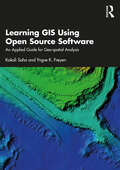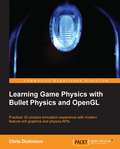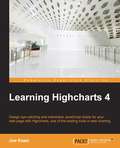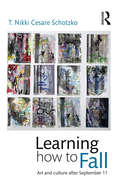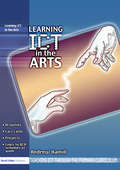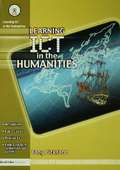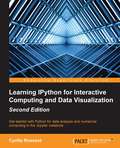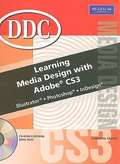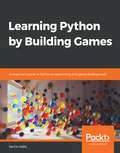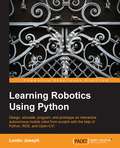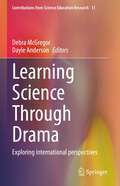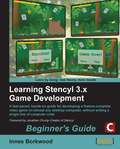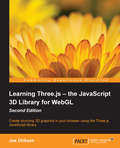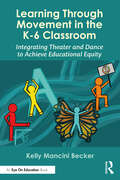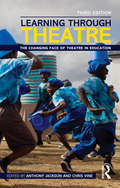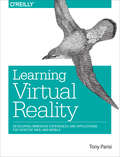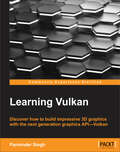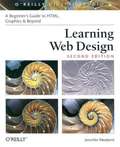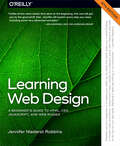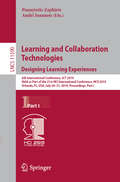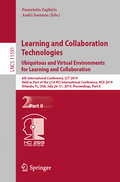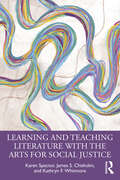- Table View
- List View
Learning GIS Using Open Source Software: An Applied Guide for Geo-spatial Analysis
by Kakoli Saha Yngve K. FrøyenThis book introduces the usage, functionality, and application of data in geographic information systems (GIS) for geo-spatial analysis. It offers knowledge on GIS tools and techniques and explains how they can be applied in real-world project to architects and planners in the Indian and the Greater South Asian context using open-source software. The volume explains concepts on planning and architectural tasks, their data, methods and requirements followed, and includes GIS-related exercises on the same tasks. It takes the reader through the concepts of geo-spatial analysis and its referencing system while quoting examples from India. Further, the content of the book will help the planners involved in preparing GIS-based master planning for cities under the Atal Mission for Rejuvenation and Urban Transformation (AMRUT) scheme (see Glossary for details). A practical guidebook providing a step-by-step guide to learn open source GIS, this book will be useful for students, scholars and professionals from the field of architecture and planning, geography and other spatial sciences, instructors of GIS course on planning and architecture, urban and regional planners, transport planners, urban design, landscape architects, environmental planners, departments of town and country planning, and development authorities. It will also be useful for anyone interested in the geospatial analysis.
Learning Game Physics with Bullet Physics and OpenGL
by Chris DickinsonA comprehensive set of straight-forward, easy-to-follow tutorials in OpenGL and Bullet Physics that will teach you how modern game physics and 3D graphics work.If you're a beginner or intermediate programmer with a basic understanding of 3D mathematics, and you want a stronger foundation in 3D graphics and physics, then this book is perfect for you! You'll even learn some of the fundamental concepts in 3D mathematics and software design that lies beneath them both, discovering some techniques and tricks in graphics and physics that you can use in any game development project.
Learning Highcharts
by Joe KuanA complete practical and comprehensive tutorial with clear and step-by-step instructions along with many examples. It's packed with examples, code samples and practical tips in a no-nonsense way. This book is both for beginners and advanced web developers who need to create interactive charts for their web applications. It primarily targets JavaScript Web developers who want to use the Highcharts library to prepare interactive and professional-quality charts and graphs for their applications quickly and easily. Prior experience with JavaScript is assumed.
Learning How to Fall: Art and Culture after September 11
by T Nikki Cesare SchotzkoBeginning with Richard Drew’s controversial photograph of a man falling from the North Tower of the World Trade Center on September 11, Learning How to Fall investigates the changing relationship between world events and their subsequent documentation, asking: Does the mediatization of the event overwhelm the fact of the event itself? How does the mode by which information is disseminated alter the way in which we perceive such information? How does this impact upon our memory of an event? T. Nikki Cesare Schotzko posits contemporary art and performance as not only a stylized re-envisioning of daily life but, inversely, as a viable means by which one might experience and process real-world political and social events. This approach combines two concurrent and contradictory trends in aesthetics, narrative, and dramaturgy: the dramatization of real-world events so as to broaden the commercial appeal of those events in both mainstream and alternative media, and the establishment of a more holistic relationship between politically and aesthetically motivated modes of disseminating and processing information. By presenting engaging and diverse case studies from both the art world and popular culture – including Aliza Shvarts’s censored senior thesis at Yale University, Kerry Skarbakka’s provocative photographs of falling, Didier Morelli’s crawl through Toronto, and Aaron Sorkin’s The Newsroom – Learning How to Fall creates a new understanding of the relationship between the event and its documentation, where even the truth of an event might be called into question.
Learning ICT in the Arts (Teaching ICT through the Primary Curriculum)
by Andrew HamillProviding practical guidance on enhancing learning through ICT in the arts, this book is made up of a series of projects that supplement, augment and extend the QCA ICT scheme and provide much-needed links with Units in other subjects’ schemes of work. It includes: examples and advice on enhancing learning through ICT in art, music, drama and design technology fact cards that support each project and clearly outline its benefits in relation to teaching and learning examples of how activities work in 'real' classrooms links to research, inspection evidence and background reading to support each project adaptable planning examples and practical ideas provided on an accompanying CD ROM. This book is invaluable reading for all trainee and practising primary teachers.
Learning ICT in the Humanities (Teaching ICT through the Primary Curriculum)
by Tony PickfordProviding practical guidance on enhancing learning through ICT in the humanities, this book is made up of a series of projects that supplement, augment and extend the QCA ICT scheme and provide much-needed links with Units in other subjects’ schemes of work. It includes: examples and advice on enhancing learning through ICT in history, geography and RE fact cards that support each project and clearly outline its benefits in relation to teaching and learning examples of how activities work in 'real' classrooms links to research, inspection evidence and background reading to support each project adaptable planning examples and practical ideas provided on an accompanying CD ROM. Suitable for all trainee and practising primary teachers.
Learning IPython for Interactive Computing and Data Visualization Second Edition
by Cyrille Rossant<P><P>Get started with Python for data analysis and numerical computing in the Jupyter notebookAbout This BookLearn the basics of Python in the Jupyter NotebookAnalyze and visualize data with pandas, NumPy, matplotlib, and seabornPerform highly-efficient numerical computations with Numba, Cython, and ipyparallelWho This Book Is ForThis book targets students, teachers, researchers, engineers, analysts, journalists, hobbyists, and all data enthusiasts who are interested in analyzing and visualizing real-world datasets. If you are new to programming and data analysis, this book is exactly for you. If you're already familiar with another language or analysis software, you will also appreciate this introduction to the Python data analysis platform. Finally, there are more technical topics for advanced readers. No prior experience is required; this book contains everything you need to know.What You Will LearnInstall Anaconda and code in Python in the Jupyter NotebookLoad and explore datasets inter
Learning Python by Building Games: A beginner's guide to Python programming and game development
by Sachin KafleExplore modern game development and programming techniques to build games using Python and its popular libraries such as Pygame and PyOpenGL Key Features Learn game development and Python through a practical, example-driven approach Discover a variety of game development techniques to build games that gradually increase in complexity Leverage popular Python gaming libraries such as Pygame, PyOpenGL, Pymunk, and Pyglet Book Description A fun and interactive way to get started with the Python language and its libraries is by getting hands-on with game development. Learning Python by Building Games brings you the best of both worlds. The book will first introduce you to Python fundamentals, which you will then use to develop a basic game. You'll gradually explore the different Python libraries best suited for game development such as Pygame, Pyglet, and PyOpenGL. From building game characters through to using 3D animation techniques, you'll discover how to create an aesthetic game environment. In addition to this, you'll focus on game physics to give your effects a realistic feel, complete with movements and collisions. The book will also cover how you can use particle systems to simulate phenomena such as an explosion or smoke. In later chapters, you will gain insights into object-oriented programming by modifying a snake game, along with exploring GUI programming to build a user interface with Python's turtle module. By the end of this book, you'll be well-versed with Python programming concepts and popular libraries, and have the confidence to build your own games What you will learn Explore core Python concepts by understanding Python libraries Build your first 2D game using Python scripting Understand concepts such as decorators and properties in the Python ecosystem Create animations and movements by building a Flappy Bird-like game Design game objects and characters using Pygame, PyOpenGL, and Pymunk Add intelligence to your gameplay by incorporating game artificial intelligence (AI) techniques using Python Who this book is for If you are completely new to Python or game programming and want to develop your programming skills, then this book is for you. The book also acts as a refresher for those who already have experience of using Python and want to learn how to build exciting games.
Learning Robotics Using Python
by Lentin JosephIf you are an engineer, a researcher, or a hobbyist, and you are interested in robotics and want to build your own robot, this book is for you. Readers are assumed to be new to robotics but should have experience with Python.
Learning Science Through Drama: Exploring international perspectives (Contributions from Science Education Research #11)
by Dayle Anderson Debra McGregorThis book presents a wide range of international perspectives that explore the different ways the diverse forms of drama supports learning in science. It illustrates how learning science by adopting and adapting theatrical techniques can offer more inclusive ways for students to relate to scientific ideas and concepts. The theatrical processes by which subject matter can be introduced, thought about, discussed, transformed, enacted and disseminated are shown to be endless. The first section of the book considers different ways of theorising and applying drama in classrooms. The second section provides a range of case studies illustrating how role play, performance, embodiment and enquiry approaches can be utilised for learning in primary, secondary and tertiary education contexts. The third section demonstrates how different research methods from questionnaires, particular kinds of tests and even the theatrical conventions themselves can provide rich data that informs how drama impacts on learning science.
Learning Spaces in Africa: Critical Histories to 21st Century Challenges and Change
by Ola UdukuWith a key UN Sustainable Development Goal for 2030 being to make basic education available to all the world’s children, Learning Spaces in Africa explores the architectural, socio-political and economic policy factors that have contributed to school design, the main spaces for education and learning in Africa. It traces the development of school building design, focusing on Western and Southern Africa, from its emergence in the 19th century to the present day. Uduku’s analysis draws attention to the past historic links of schools to development processes, from their early 19th century missionary origins to their re-emergence as development hubs in the 21st century. Learning Spaces in Africa uses this research as a basis to suggest fundamental changes to basic education, which respond to new technological advances, and constituencies in learning. Illustrated case studies describe the use of tablets in refugee community schools, "hole-in-the wall" learning and shared school-community learning spaces. This book will be beneficial for students, academics and those interested in the history of educational architecture and its effect on social development, particularly in Africa and with relevance to countries elsewhere in the emerging world.
Learning Stencyl 3.x Game Development: Beginner's Guide
by Innes BorkwoodA step-by-step, practical tutorial with a no-nonsense approach. The book starts by showing readers how to create a playable game that is fully-functioning, then moves on to demonstrate how to fine-tune the game with eye-catching graphics techniques, audio-effects and more.This book is for indie and existing game developers and those who want to get started with game development using Stencyl. Some understanding of Objective-C, C++, and game development basics is recommended. People with some programming experience may also find this book useful.
Learning Three.js – the JavaScript 3D Library for WebGL - Second Edition
by Jos DirksenIf you know JavaScript and want to start creating 3D graphics that run in any browser, this book is a great choice for you. You don't need to know anything about math or WebGL; all that you need is general knowledge of JavaScript and HTML.
Learning Through Movement in the K-6 Classroom: Integrating Theater and Dance to Achieve Educational Equity
by Kelly Mancini BeckerThis book offers a creative and practical guide for K-6 teachers on how to effectively integrate movement into the curriculum to increase student engagement, deepen learning, improve retention, and get kids moving during the school day. Chapters offer concrete ideas for integrating creative movement and theater into subjects such as math, science, literacy, and social studies. Drawing on two decades of experience, Dr. Becker outlines key skills, offers rich examples, and provides adaptable and flexible classroom tested lesson plans that align with Common Core Standards, the NGSS, C3 Social Studies Standards, and the National Core Arts Standards. Activities are grounded in arts integration, which is steadily gaining interest in school reform as an effective teaching strategy that increases student outcomes academically and socially—particularly effective for students who have traditionally been marginalized. This book will benefit practicing educators who want to invigorate their practice, preservice teachers who want to expand their toolkit, and school leaders looking to employ policies that support movement and arts during the school day. Jump in and get your kids Learning Through Movement and see how active and engaging learning can be!
Learning Through Movement in the K-6 Classroom: Integrating Theater and Dance to Achieve Educational Equity
by Kelly Mancini BeckerThis book offers a creative and practical guide for K-6 teachers on how to effectively integrate movement into the curriculum to increase student engagement, deepen learning, improve retention, and get kids moving during the school day.Chapters offer concrete ideas for integrating creative movement and theater into subjects such as math, science, literacy, and social studies. Drawing on two decades of experience, Dr. Becker outlines key skills, offers rich examples, and provides adaptable and flexible classroom tested lesson plans that align with Common Core Standards, the NGSS, C3 Social Studies Standards, and the National Core Arts Standards. Activities are grounded in arts integration, which is steadily gaining interest in school reform as an effective teaching strategy that increases student outcomes academically and socially—particularly effective for students who have traditionally been marginalized.This book will benefit practicing educators who want to invigorate their practice, preservice teachers who want to expand their toolkit, and school leaders looking to employ policies that support movement and arts during the school day. Jump in and get your kids Learning Through Movement and see how active and engaging learning can be!
Learning Through Theatre: The Changing Face of Theatre in Education
by Chris Vine Anthony JacksonIn the two decades since the publication of the second edition, Learning Through Theatre has further established itself as an indispensable resource for scholars, practitioners and educators interested in the complex interrelations between teaching and learning, the performing arts, and society at large. Theatre in Education (TIE) has consistently been at the cutting edge of the ever-growing field of Applied Theatre; this comprehensively revised new edition makes an international case for why, and how, it will continue to shape ways in which the participatory arts contribute to the learning of young people (and increasingly, adults) in the 21st century. Drawing on the experiences and insights of theorists and practitioners from across the world, Learning Through Theatre shows how theatre can, and does, promote: participatory engagement; the use of innovative theatrical form; work with young people and adults in a range of educational settings; and social and personal change. Now transatlantically edited by Anthony Jackson and Chris Vine, Learning Through Theatre offers exhilarating new reflections on the book’s original aim: to define, describe and debate the salient features, and wider political context, of one of the most important – and radical – developments in contemporary theatre.
Learning To Draw
by Robert KaupelisFull of inventive and stimulating projects designed to develop observation skills and creativity, this book approaches drawing as a process of personal discovery through improvisation. Richly illustrated with drawings by old and modern masters.
Learning Virtual Reality: Developing Immersive Experiences and Applications for Desktop, Web, and Mobile
by Tony ParisiAs virtual reality approaches mainstream consumer use, a vibrant development ecosystem has emerged in the past few years. This hands-on guide takes you through VR development essentials for desktop, mobile, and browser-based applications. You’ll explore the three go-to platforms—OculusVR, Gear VR, and Cardboard VR—as well as several VR development environments, programming tools, and techniques.If you’re an experienced programmer familiar with mobile development, this book will help you gain a working knowledge of VR development through clear and simple examples. Once you create a complete application in the final chapter, you’ll have a jumpstart on the next major entertainment medium.Learn VR basics for UI design, 3D graphics, and stereo renderingExplore Unity3D, the current development choice among game enginesCreate native applications for desktop computers with the Oculus RiftDevelop mobile applications for Samsung’s Gear VR with the Android and Oculus Mobile SDKsBuild browser-based applications with the WebVR Javascript API and WebGLCreate simple and affordable mobile apps for any smartphone with Google’s Cardboard VRBring everything together to build a 360-degree panoramic photo viewer
Learning Vulkan
by Parminder SinghDiscover how to build impressive 3D graphics with the next-generation graphics API—Vulkan About This Book • Get started with the Vulkan API and its programming techniques using the easy-to-follow examples to create stunning 3D graphics • Understand memory management in Vulkan and implement image and buffer resources • Get hands-on with the drawing process and synchronization, and render a 3D graphics scene with the Vulkan graphics pipeline Who This Book Is For This book is ideal for graphic programmers who want to get up and running with Vulkan. It's also great for programmers who have experience with OpenGL and other graphic APIs who want to take advantage of next generation APIs. A good knowledge of C/C++ is expected. What You Will Learn • Learn fundamentals of Vulkan programing model to harness the power of modern GPU devices. • Implement device, command buffer and queues to get connected with the physical hardware. • Explore various validation layers and learn how to use it for debugging Vulkan application. • Get a grip on memory management to control host and device memory operations. • Understand and implement buffer and image resource types in Vulkan. • Define drawing operations in the Render pass and implement graphics pipeline. • Manage GLSL shader using SPIR-V and update the shader resources with descriptor sets and push constants. • Learn the drawing process, manage resources with synchronization objects and render 3D scene output on screen with Swapchain. • Bring realism to your rendered 3D scene with textures, and implement linear and optimal textures In Detail Vulkan, the next generation graphics and compute API, is the latest offering by Khronos. This API is the successor of OpenGL and unlike OpenGL, it offers great flexibility and high performance capabilities to control modern GPU devices. With this book, you'll get great insights into the workings of Vulkan and how you can make stunning graphics run with minimum hardware requirements. We begin with a brief introduction to the Vulkan system and show you its distinct features with the successor to the OpenGL API. First, you will see how to establish a connection with hardware devices to query the available queues, memory types, and capabilities offered. Vulkan is verbose, so before diving deep into programing, you'll get to grips with debugging techniques so even first-timers can overcome error traps using Vulkan's layer and extension features. You'll get a grip on command buffers and acquire the knowledge to record various operation commands into command buffer and submit it to a proper queue for GPU processing. We'll take a detailed look at memory management and demonstrate the use of buffer and image resources to create drawing textures and image views for the presentation engine and vertex buffers to store geometry information. You'll get a brief overview of SPIR-V, the new way to manage shaders, and you'll define the drawing operations as a single unit of work in the Render pass with the help of attachments and subpasses. You'll also create frame buffers and build a solid graphics pipeline, as well as making use of the synchronizing mechanism to manage GPU and CPU hand-shaking. By the end, you'll know everything you need to know to get your hands dirty with the coolest Graphics API on the block. Style and approach This book takes a practical approach to guide you through the Vulkan API, and you will get to build an application throughout the course of the book. Since you are expected to be familiar with C/C++, there is not much hand-holding throughout the course of the book.
Learning Web Design, 2nd Edition
by Jennifer Niederst RobbinsIn Learning Web Design , author Jennifer Niederst shares the knowledge she's gained from years of web design experience, both as a designer and a teacher. This book starts from the beginning-- defining the Internet, the Web, browsers, and URLs -- so you don't need to have any previous knowledge about how the Web works. After reading this book, you'll have a solid foundation in HTML, graphics, and design principles that you can immediately put to use in creating effective web pages. In the second edition, Jennifer has updated the book to cover style sheets and reflect current web standards. She has also added exercises that help you to learn various techniques and short quizzes that make sure you're up to speed with key concepts. The companion CD-ROM contains material for all the exercises in the book, as well as trial versions of Fireworks MX, and HomeSite 5; Adobe Photoshop 7, ImageReady 7, and BBEdit 7.* Learning Web Design , 2nd Edition: Covers the nuts and bolts of basic HTML and style sheets, with detailed examples of formatting text, adding graphic elements, making links, creating tables and frames, and using color on the Web. Explains whether to use GIFs or JPEGs for different types of images, and includes important tips on optimizing graphics for web delivery. Provides dozens of web design do and don'ts, to help you make good web design decisions and avoid common beginner traps. Contains hands-on exercises throughout the book that allow you to try out new techniques along the way. Unlike other beginner books, Learning Web Design leaves no holes in your education. It gives you everything you need to create basic web sites and will prepare you for more advanced web work. If you are interested in web design, this book is the place to start. After finishing it, you'll be ready for the author's bestselling companion reference, Web Design in a Nutshell . * Fireworks and HomeSite are trademarks or registered trademarks of Macromedia, Inc. in the United States and/or other countries. Adobe, ImageReady, and Photoshop are either registered trademarks or trademarks of Adobe Systems Incorporated in the United States and/or other countries.
Learning Web Design: A Beginner's Guide to HTML, CSS, JavaScript, and Web Images
by Jennifer RobbinsDo you want to build web pages but have no prior experience? This friendly guide is the perfect place to start. You'll begin at square one, learning how the web and web pages work, and then steadily build from there. By the end of the book, you'll have the skills to create a simple site with multicolumn pages that adapt for mobile devices. Each chapter provides exercises to help you learn various techniques and short quizzes to make sure you understand key concepts. This thoroughly revised sixth edition is ideal for students and professionals of all backgrounds and skill levels. It's simple and clear enough for beginners yet thorough enough to be a useful reference for experienced developers keeping their skills up-to-date. Build HTML pages with text, links, images, tables, and forms Use style sheets (CSS) for formatting text, colors, backgrounds, page layout, and simple animation effects Use CSS Flexbox and Grid Layout for sophisticated and flexible page designs Learn the ins and outs of responsive web design to make web pages look great on all devices Get an introductory lesson in JavaScript programming, and use it to add functionality to web pages Understand the ways in which JavaScript has become central to the web development workflow Create and optimize web images so they'll download as quickly as possible Get to know the superpowers of the SVG format </p? The sixth edition features a completely rewritten and expanded JavaScript section written by Aaron Gustafson that provides more opportunities to practice writing code.
Learning and Collaboration Technologies. Designing Learning Experiences: 6th International Conference, LCT 2019, Held as Part of the 21st HCI International Conference, HCII 2019, Orlando, FL, USA, July 26–31, 2019, Proceedings, Part I (Lecture Notes in Computer Science #11590)
by Panayiotis Zaphiris Andri IoannouThis two-volume set LNCS 11590 and 11591 constitutes the refereed proceedings of the 6th International Conference on Learning and Collaboration Technologies, LCT 2019, held as part of the 21st International Conference on Human-Computer Interaction, HCII 2019, in Orlando, FL, USA in July 2019. The 1274 full papers and 209 posters presented at the HCII 2019 conferences were carefully reviewed and selected from 5029 submissions. The papers cover the entire field of human-computer interaction, addressing major advances in knowledge and effective use of computers in a variety of applications areas. The papers in this volume are organized in the following topical sections: designing and evaluating learning experiences; theoretical and pedagogical approaches in technology-enhanced learning; cognitive and psychological issues in learning; and technology in STEM education.
Learning and Collaboration Technologies. Ubiquitous and Virtual Environments for Learning and Collaboration: 6th International Conference, LCT 2019, Held as Part of the 21st HCI International Conference, HCII 2019, Orlando, FL, USA, July 26–31, 2019, Proceedings, Part II (Lecture Notes in Computer Science #11591)
by Panayiotis Zaphiris Andri IoannouThis two-volume set LNCS 11590 and 11591 constitutes the refereed proceedings of the 6th International Conference on Learning and Collaboration Technologies, LCT 2019, held as part of the 21st International Conference on Human-Computer Interaction, HCII 2019, in Orlando, FL, USA in July 2019. The 1274 full papers 209 posters presented at the HCII 2019 conferences were carefully reviewed and selected from 5029 submissions. The papers cover the entire field of human-computer interaction, addressing major advances in knowledge and effective use of computers in a variety of applications areas. The papers in this volume are organized in the following topical sections: mobile and ubiquitous learning; virtual reality and augmented reality systems for learning; and collaborative technology.
Learning and Teaching Literature with the Arts for Social Justice
by James S. Chisholm Kathryn F. Whitmore Karen SpectorThis text invites pre-service teachers to explore arts-informed practices that showcase the transformative potential of literature in the classroom. Through the lens of "stories-we-live-by," the authors recognize literature as interference, capable of disrupting the habitual patterns through which we interpret the world in order to reawaken the capacity of students and teachers alike to change. Chapters are designed to inspire students’ love of literature by fostering literary and artful encounters that provoke their thinking and sense-making. Each chapter includes engaging pedagogical features that spark thinking and analysis of literature and invite readers to further engagement. The appendices include directions for instruction as well as additional resources. An essential text for courses on children’s and adolescent literature and English methods, pre-service teachers will come away with plenty of text recommendations and arts- and social justice-informed practices to use with their future students. Through artful encounters with visual learning analyses, visual-verbal journals, drama, soundscapes, poetry, and so much more, readers examine their own transformative experiences with literature. Readers will learn to craft and curate practices that encourage engagement, imagination, experimentation, and self-awareness in and beyond the classroom.
